Tele Radio C1602A Transceiver radio modular User Manual My
Tele Radio AB Transceiver radio modular My
Contents
User manual
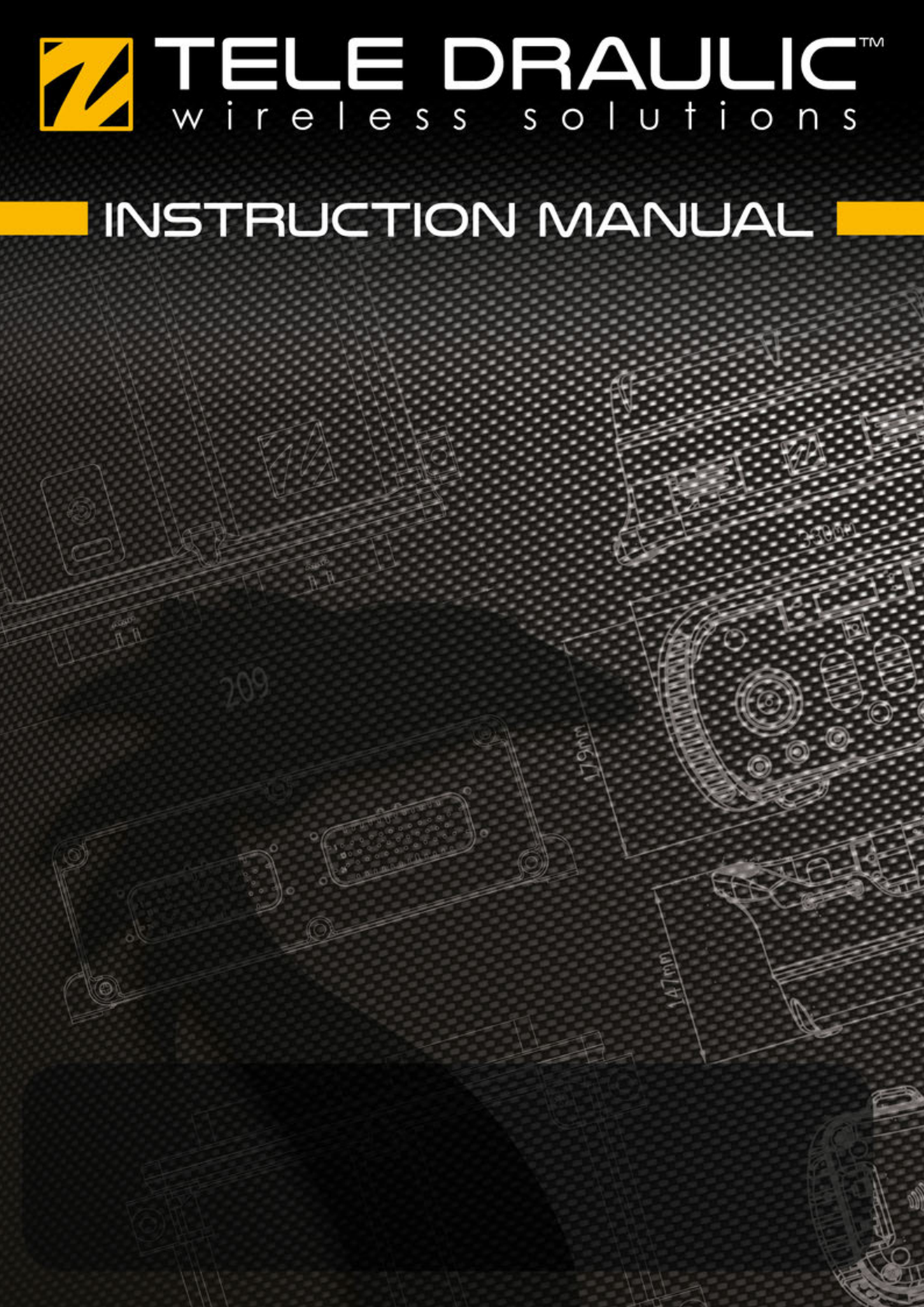
Transmitters
HY-T24-1, HY-T24-3, HY-T24-81, HY-T24-82, HY-T24-83
IM-HY-TX101-A02-CERT

CONTENTS
Chapter 1: INTRODUCTION
1.1 Thank you for purchasing a Tele Draulic™ product 3
1.2 About 4
Chapter 2: SAFETY
2.1 Safety 5
2.2 Functionality test 6
Chapter 3: PRODUCT DESCRIPTION
3.1 Transmitter bottom view – all transmitters 7
3.2 HY-T24-81 8
3.3 HY-T24-82 9
3.4 HY-T24-83 10
3.5 Transmitter display 11
3.6 LEDs on receiver 13
Chapter 4: TECHNICAL DATA
Chapter 5: OPERATION
5.1 Start-up procedure 17
5.2 Maintenance 18
Chapter 6: REGULATORY
6.1 CE marking 19
6.2 FCC statement 19
6.3 IC statement 20
6.4 FCC/IC label placement 21
6.5 Product label on the transmitter 21
6.6 The radio module 21

Chapter 1: INTRODUCTION
1.1 Thank you for purchasing a Tele Draulic™ product
READ ALL INSTRUCTIONS AND WARNINGS CAREFULLY BEFORE MOUNTING,
INSTALLING AND CONFIGURATING THE PRODUCT.
These instructions are published by Tele Draulic and are not subject to any guarantee. The instruc-
tions may be removed or revised by Tele Draulic at any time and without further notice. Cor-
rections and additions will be added to the latest version of the instructions.
IMPORTANT! Parts of these instructions are directed to installers only. The instructions con-
taining information about the installation and configuration of the radio remote control unit on the
machine are not intended to be passed on to the end user. Such information is marked "Installers
only". Only information that is needed to operate the machine correctly by radio remote control
may be passed on to the end user.
Tele Draulic products are covered by a guarantee/warranty against material, construction or man-
ufacturing faults. During the guarantee/warranty period, Tele Draulic may replace the product or
faulty parts. Work under guarantee/warranty must be carried out by Tele Draulic or by an author-
ized service center specified by Tele Draulic. Contact your Tele Draulic representative if you need
support or service.
©Tele Draulic
Information in this document is subject to change without notice. The software described in this
document is furnished under a license agreement or nondisclosure agreement. The software may
be used or copied only in accordance with the terms of those agreements. No part of this pub-
lication may be reproduced, stored in a retrieval system, or transmitted in any form or any means
electronic or mechanical, including photocopying and recording for any purpose other than the pur-
chaser's personal use without the written permission of Tele Draulic.
Tele Draulic
16520 E. Laser Drive, Suite 2
Fountain Hills, AZ 85268
Phone 1-(480)-404-9546
3
1.2 About
Before installing or operating the product, carefully read the instructions belonging to it.
Hydra products are used together with different transmitters/receivers from the Hydra family. For
your specific system see the technical documentation.
Hydra mainly caters the Hydraulic market. The systems are not standardized but adjusted to the
clients needs. This manual covers safety issues, installation instructions, battery information, an
operators guide and troubleshooting. All drawings are unique and delivered with your order.
Images shown in this instruction may not show the exact position for buttons, paddles and more.
How the outputs are connected to control the object depends on the specific installation and will
not be covered in this instruction. For exact details please see the technical documentation for
your specific system.
CHAPTER 1│Installation instruction
4

Chapter 2: SAFETY
2.1 Safety
To ensure safe operations this manual must be carefully read and understood before installing and
operating the product. Installation must be made by authorized and educated personnel and
according to the local laws and regulations. Failure to follow these instructions may cause death,
serious injuries and material damages.
User
The following details must be considered for all handling of the system.
lHydra products must not be operated without access to the manual, the technical doc-
umentation and needed safety training. The purchaser of this Hydra has been instructed how
to handle the system safely.
lAllow only licensed or qualified personnel to install the product.
lAllow only qualified personnel to have access to the transmitter and operate the equipment.
lMake sure that the user follows the instructions.
lMake sure that the user satisfies the age requirements in your country for operating the equip-
ment.
lMake sure that the user is not under the influence of drugs, alcohol or medications.
lMake sure that the user does not leave the transmitter unsupervised.
lMake sure that the user always switches the transmitter off when it is not in use.
lMake sure that the user has a clear view of the work area at all times. The work area must be
free from obstacles and the user must be sure of his/her footing.
lThe user may not use broken products.
lThe user may not change any configurations without proper training.
lThe user may not remove any labels from the product.
lThe user may not use the product when the battery is low.
Installing, connecting and mounting
When installing, connecting and mounting the following must be considered at all times.
lWrite down the serial numbers/ID codes of the receivers and transmitters used.
lAllow only licensed or qualified personnel to install the product.
lAlways switch off the power supply to the receiver before connecting the equipment.
lCheck that the power supply is connected to the correct connection terminal.
lTo utilize the safety of the system, use the stop relays in the safety circuitry of the object
that you want to control
5
lDo not use damaged cables. No cables must hang loose.
lAvoid installing in areas affected by strong vibrations.
lThe receiver withstands normal weather conditions but should be protected from extreme
conditions. The receiver should also not be subjected to mechanical water pressure i.e. a
pressure washer or similar adverse conditions.
lAvoid installing the receiver in a place where it will be subjected to high water flows and/or
heavy precipitation.
lCable glands and vent plugs must fave down to prevent water from seeping in.
Maintenance
To keep the Hydra in best possible condition always consider the following details.
lIf error messages are shown, do not continue without finding out what caused them.
lIf the emergency button is mechanically damaged, contact your representative for service
immediately.
lAlways contact your representative for service and maintenance work on the product when
needed.
lWrite down the serial numbers/ID codes of the receivers and transmitters used.
lAvoid registering transmitters in receivers where they are not being used.
lKeep the safety instructions for future reference.
2.2 Functionality test
Always perform a functionality test before starting to use the system. Prior to performing a func-
tionality test, make sure that the controlled object can not do any harm in case of unexpected
movement.
lFollow local safety rules and start the equipment following instructions.
lMake sure that the transmitter can control the receiver by testing all functions and make sure
that the functions respond as expected.
lMake sure that all movements are as planned.
lMake sure that the emergency stop functions.
lMake sure that the stop function works correct.
lMake sure the system stops when both batteries are removed from the transmitter.
Note that further checks can bee added to this list depending on the use of the specific system.
CHAPTER 2│Installation instruction
6
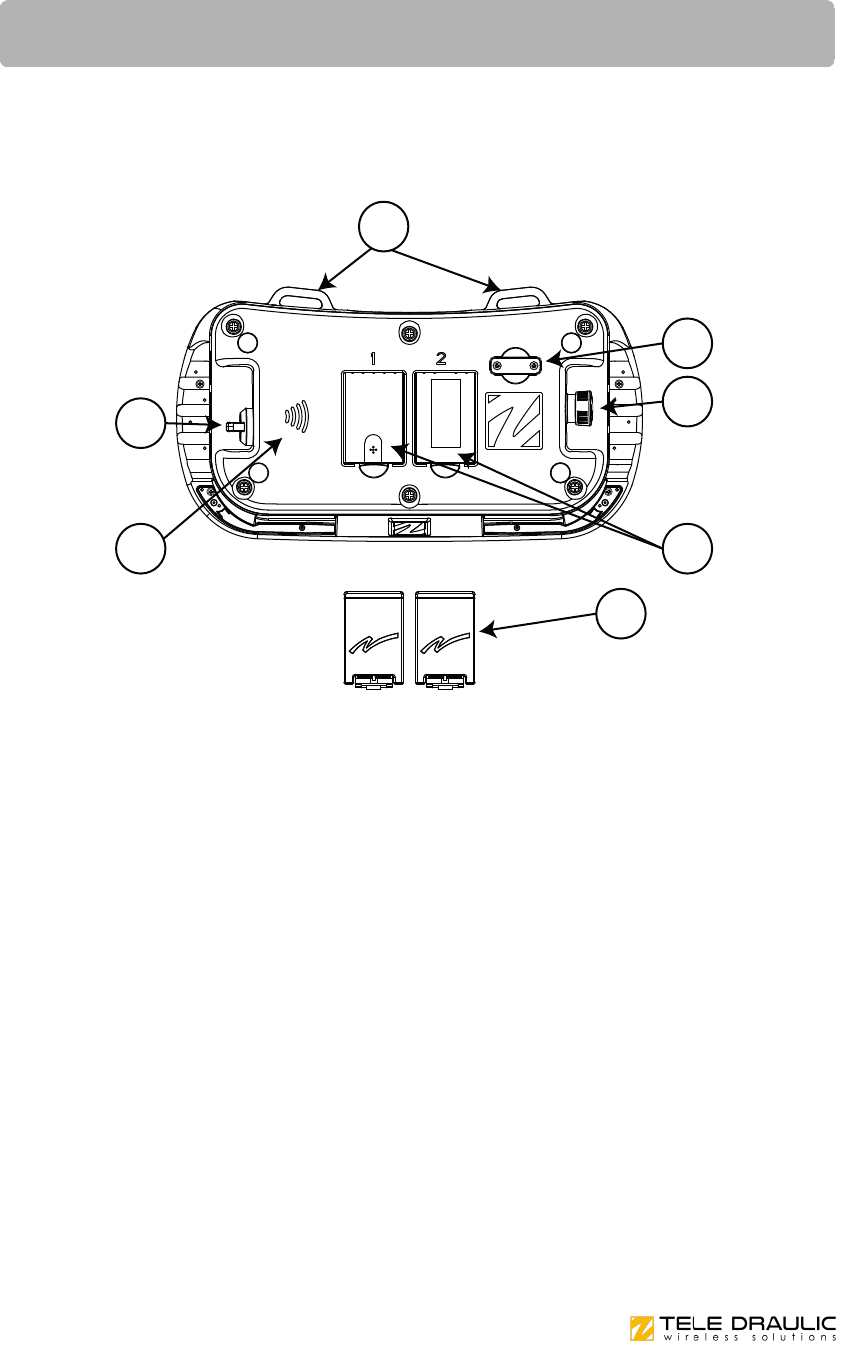
Chapter 3: PRODUCT DESCRIPTION
Note: The product pictures used in this chapter are for illustrative purposes only, actual product
appearance might be slightly different.
3.1 Transmitter bottom view – all transmitters
T24-81, T-24-82, T24-83
3
7
4
5
61
2
1. RFID antenna
2. Key switch
3. Belt loops
4. Memory card socket
5. Stop button
6. Battery compartments
7. Replaceable batteries
7
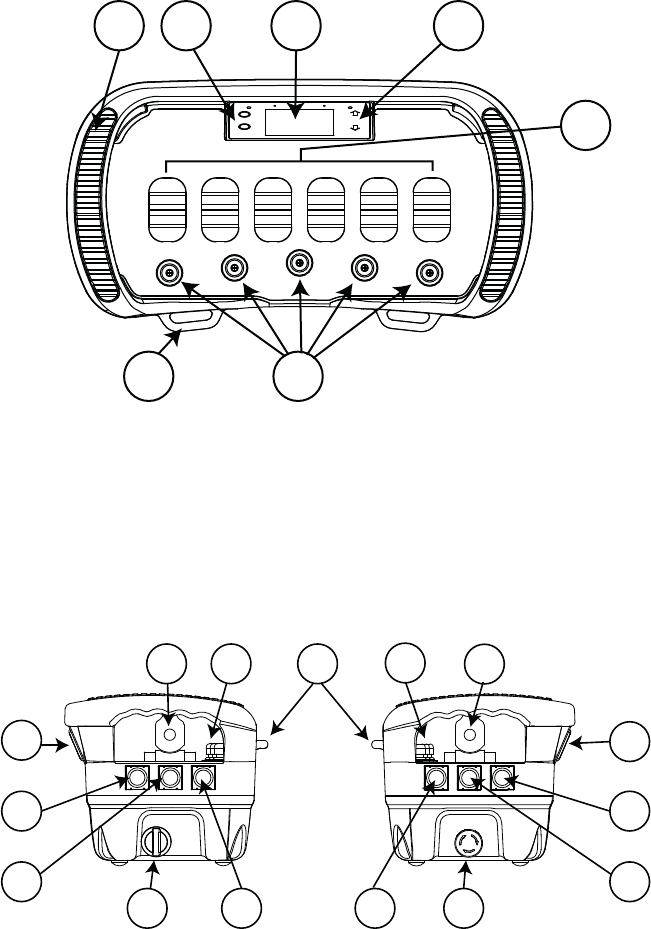
3.2 HY-T24-81
Transmitter top view
1 2 4
5
3
7 6
1. Handle bar
2. Display function buttons
3. Display
4. Display navigation buttons
5. Paddle levers 1–6
6. Buttons 1–6
7. Belt loops
Transmitter side views
33
9
854 5
111267
10
2
1
4
Left Right
1. Side button 1
2. Side button 2
3. Display
4. Paddle levers 1–6
5. Buttons 1–6
6. Side button 3
7. Key switch
8. Belt loops
9. Side button 4
10. Side button 5
11. Stop button
12. Side button 6
CHAPTER 3│Installation instruction
8
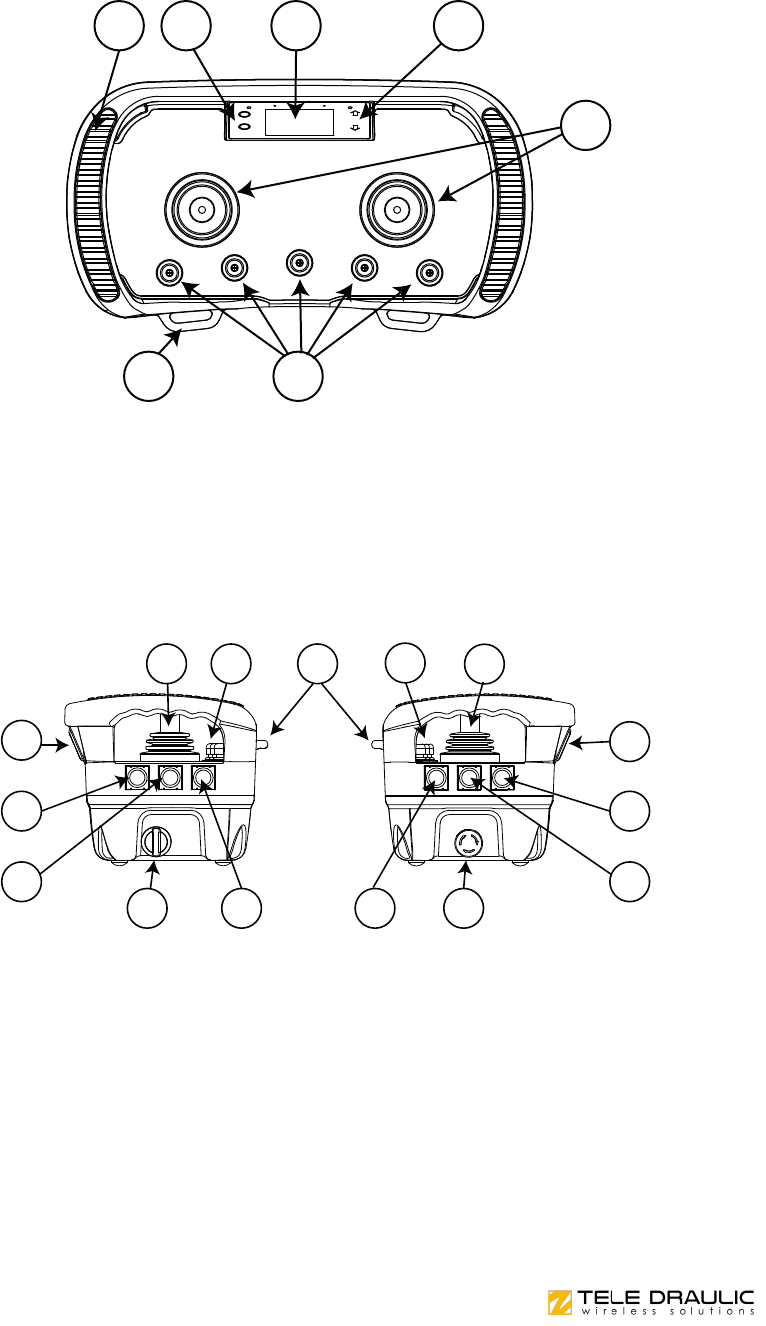
3.3 HY-T24-82
Transmitter top view
1 2 4
5
3
7 6
1. Handle bar
2. Display function buttons
3. Display
4. Display navigation buttons
5. Joystick 1–2
6. Buttons 1–6
7. Belt loops
Transmitter side views
33
9
854 5
111267
10
2
1
4
Left Right
1. Side button 1
2. Side button 2
3. Display
4. Joysticks 1–2
5. Buttons 1–6
6. Side button 3
7. Key switch
8. Belt loops
9. Side button 4
10. Side button 5
11. Stop button
12. Side button 6
9
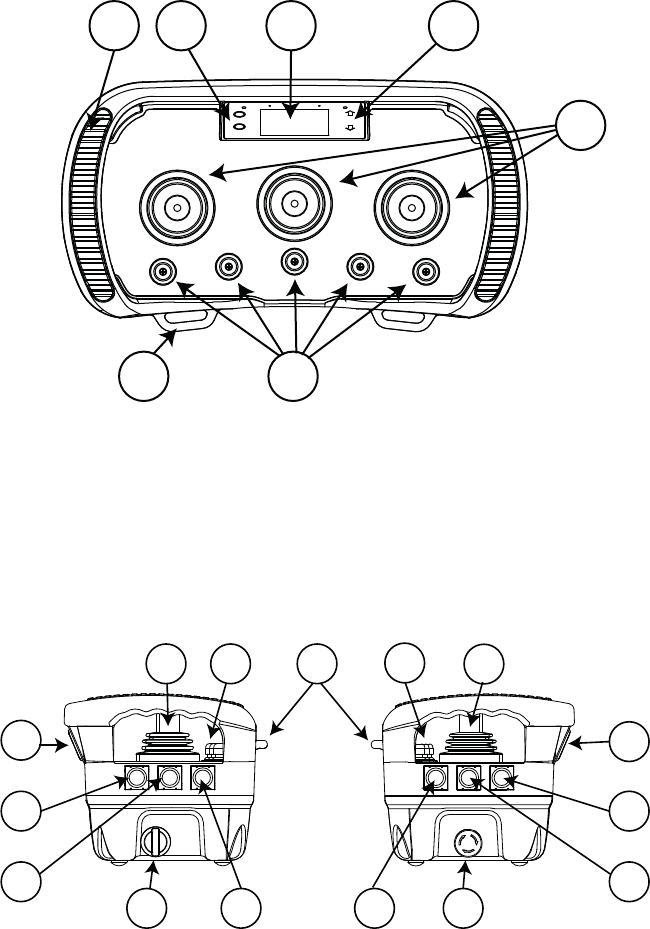
3.4 HY-T24-83
Transmitter top view
1 2 4
5
3
7 6
1. Handle bar
2. Display function buttons
3. Display
4. Display navigation buttons
5. Joysticks 1–3
6. Buttons 1–6
7. Belt loops
Transmitter side views
33
9
854 5
111267
10
2
1
4
Left Right
1. Side button 1
2. Side button 2
3. Display
4. Joysticks 1–3
5. Buttons 1–6
6. Side button 3
7. Key switch
8. Belt loops
9. Side button 4
10. Side button 5
11. Stop button
12. Side button 6
CHAPTER 3│Installation instruction
10
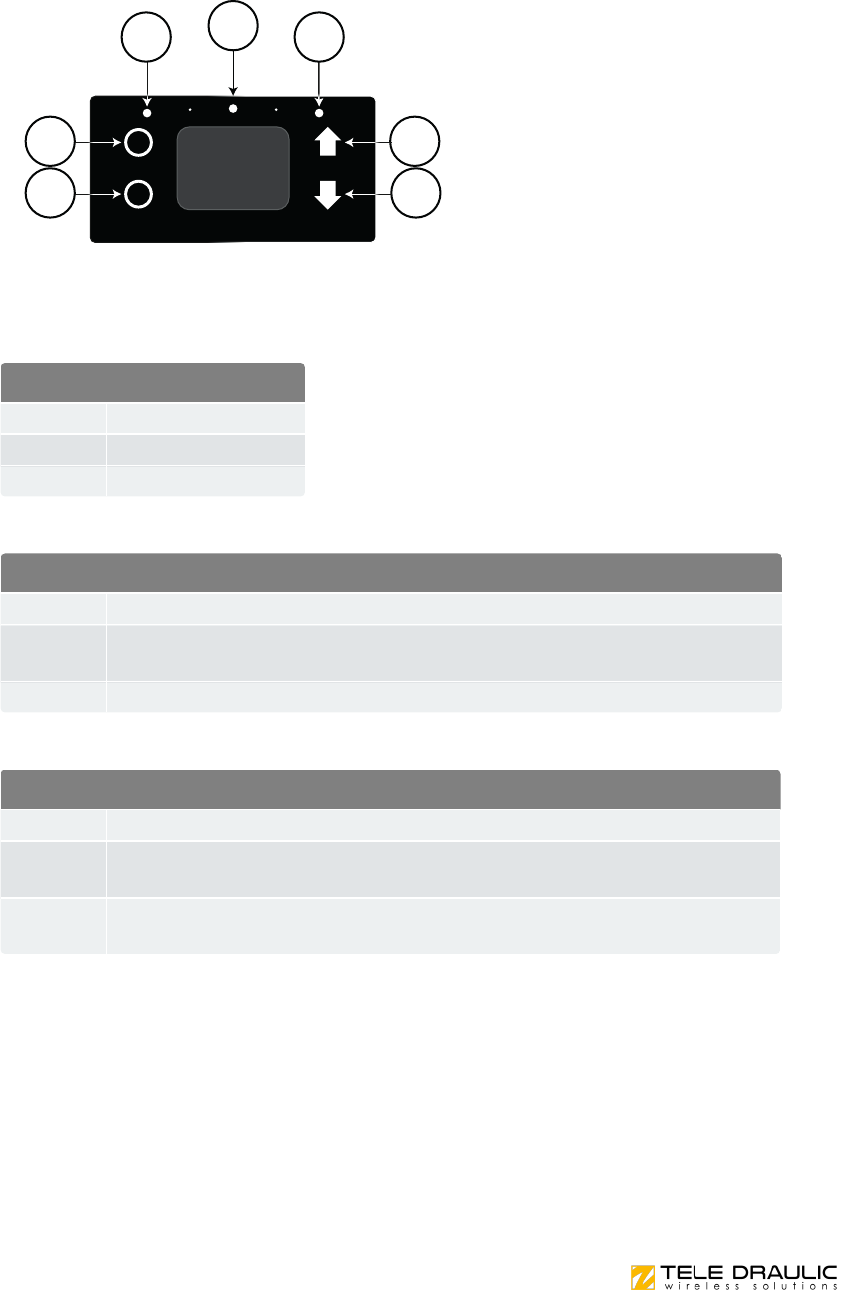
3.5 Transmitter display
The Menu system is controlled by the four buttons next to the display.
2
1
6
7
35
4
1. Back button
2. Select button
3. Battery LED 1
4. Status LED
5. Battery LED 2
6. Up
7. Down
General navigation
Main menu
Up/Down Select menu item
Select Enter the selected entry
Back Back to previous
Enter numbers
Up/Down Increase/decrease the value displayed
Select Accept the updated value, you will then be asked yes/no to confirm if you want to
save the value
Back Cancel and go back to the menu without confirmation
Select slot
Up/Down Go to the slot you want to select/deselect
Select Toggle the selection of the current slot; indicated with a + sign to the left of the selec-
tion
Back Accept currently selected slots and confirm with yes/no if you want to store and/or
continue
11
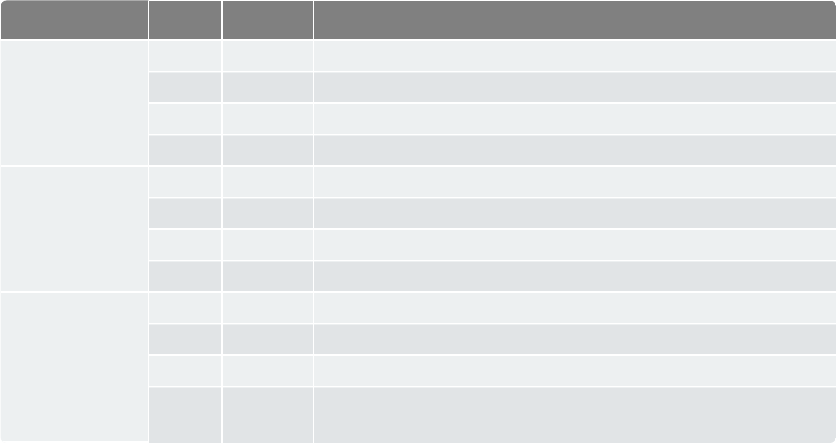
LED indications
The transmitter display area has 3 LEDs.
LEDs 1 and 2 are for battery indication. Middle LED is for radio link and system information.
LED Colour Action Indicates
Battery LED 1 green lights Battery 1 level is good.
red lights Battery 1 level is low, must be charged.
red flashes Battery 1 is charging and is not yet fully charged.
- off No battery present in battery compartment 1.
Battery LED 2 green lights Battery 2 level is good.
red lights Battery 2 level is low, must be charged.
red flashes Battery 2 is charging and is not yet fully charged.
- off No battery present in battery compartment 2.
Middle LED green lights When started, radio link ok.
green flashes When started, radio link not ok.
red lights Fatal error. More information is found on the display.
red flashes Sending stop/logout command. Information is also found on the
display.
CHAPTER 3│Installation instruction
12
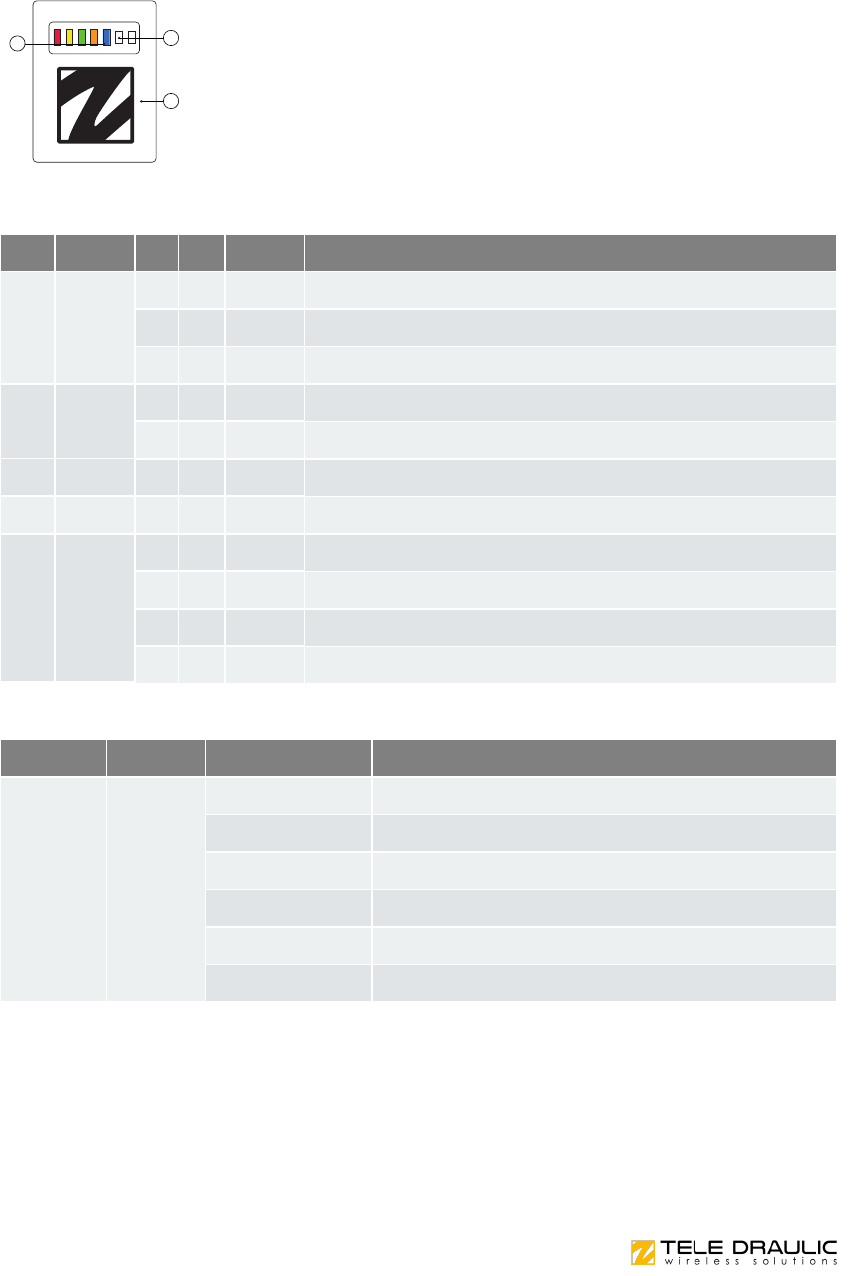
3.6 LEDs on receiver
The receiver has a button including seven LEDs showing the receiver status.
LED1
LED2
LED3
LED4
LED5
2
3
1
1. LEDs 1–5
2. DLEDs 1–2
3. Cap sensor button
LED Colour Off On Flashes Indicates
1 red x Radio link established
x No transmitter is registered
x One or more transmitters is registered, radio link is down
2 yellow x No transmitter is logged in
x One transmitter is logged in
3 yellow Not in use
4 orange Not in use
5 blue x Bluetooth not activated by settings
Slow Bluetooth stand by
Quick Bluetooth in paring mode
x Bluetooth activated and communicating
LED Colour Action Indicates
DLED1 red CANopen error LED (CAN interface 1)
Single flash Warning limit reached
Flickering AutoBaud/LSS
Double flash Error Control Event
Triple flash Sync Error
On Bus Off
13
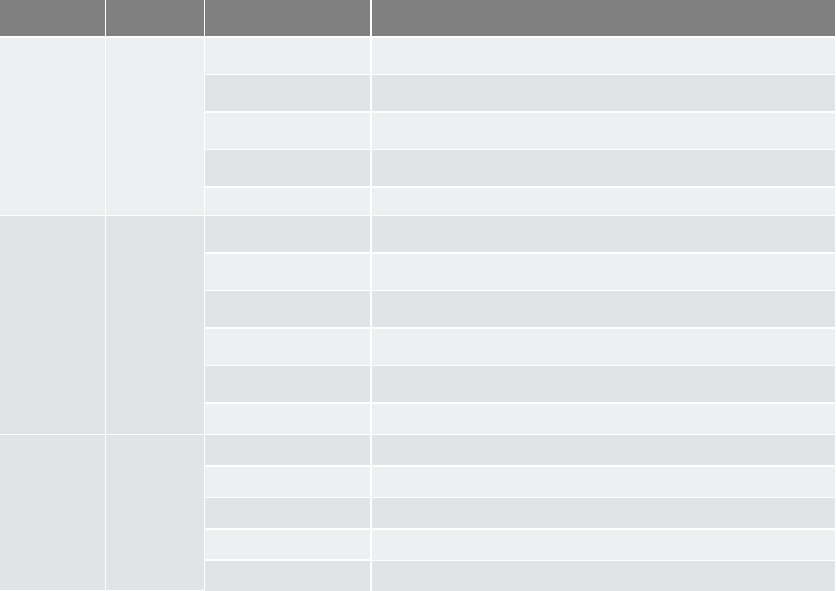
LED Colour Action Indicates
DLED1 green CANopen run LED (CAN interface 1)
Flickering AutoBaud/LSS
Single flash Stopped
Blinking Pre-operational
On Operational
DLED2 red CANopen error LED (CAN interface 2)
Single flash Warning limit reached
Flickering AutoBaud/LSS
Double flash Error Control Event
Triple flash Sync Error
On Bus Off
DLED2 green CANopen run LED (CAN interface 2)
Flickering AutoBaud/LSS
Single flash Stopped
Blinking Pre-operational
On Operational
CHAPTER 3│Installation instruction
14
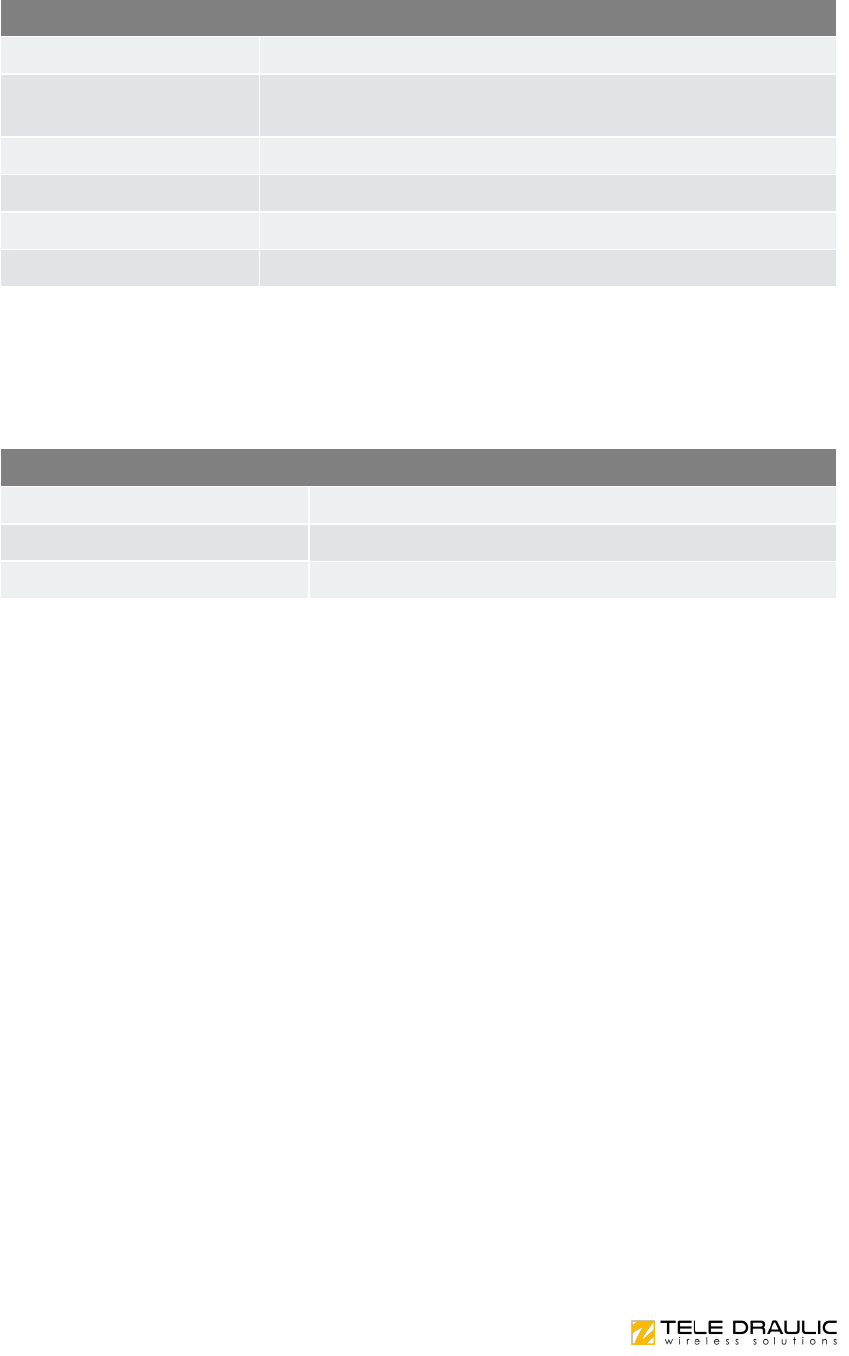
Chapter 4: TECHNICAL DATA
SYSTEMSPECIFICATIONS
Carrier frequency 2.4 GHz standard
Frequency management Direct Sequence Spread Spectrum (DSSS)
Field Strength Adaptation Feature
Range (typical) 100m (328 ft), adjustable/depending on configuration
Operating temperature -30 … + 70 °C (-30 .. +175 °F)
Pairing Easy to pair without specialty tools or opening of boxes
Bluetooth Bluetooth accessible for configuration & settings
Note that the above information may differ in customized systems, see technical documentation
for each system.
RECEIVERSPECIFICATIONHYDRA
Environmental protection IP65 (Better Nema 4)
Antenna Internal
Power supply Replaceable, rechargeable lithium-ion battery
Note that the above information may differ in customized systems, see technical documentation
for each system.
15
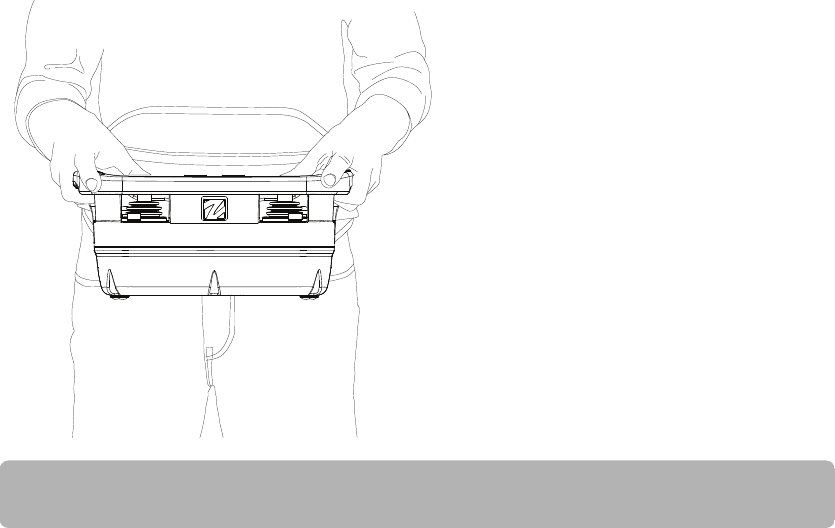
Chapter 5: OPERATION
Tele Draulic transmitters are intended to be used together with Tele Draulic waist belt, for better
support and improved ergonomic while operating the transmitter.
Adjust the belt around the waist, then hook the transmitter into the waist belt straps.
Note: The product picture above is for illustrative purposes only, actual product appearance
might be slightly different.
CHAPTER 5│Installation instruction
16
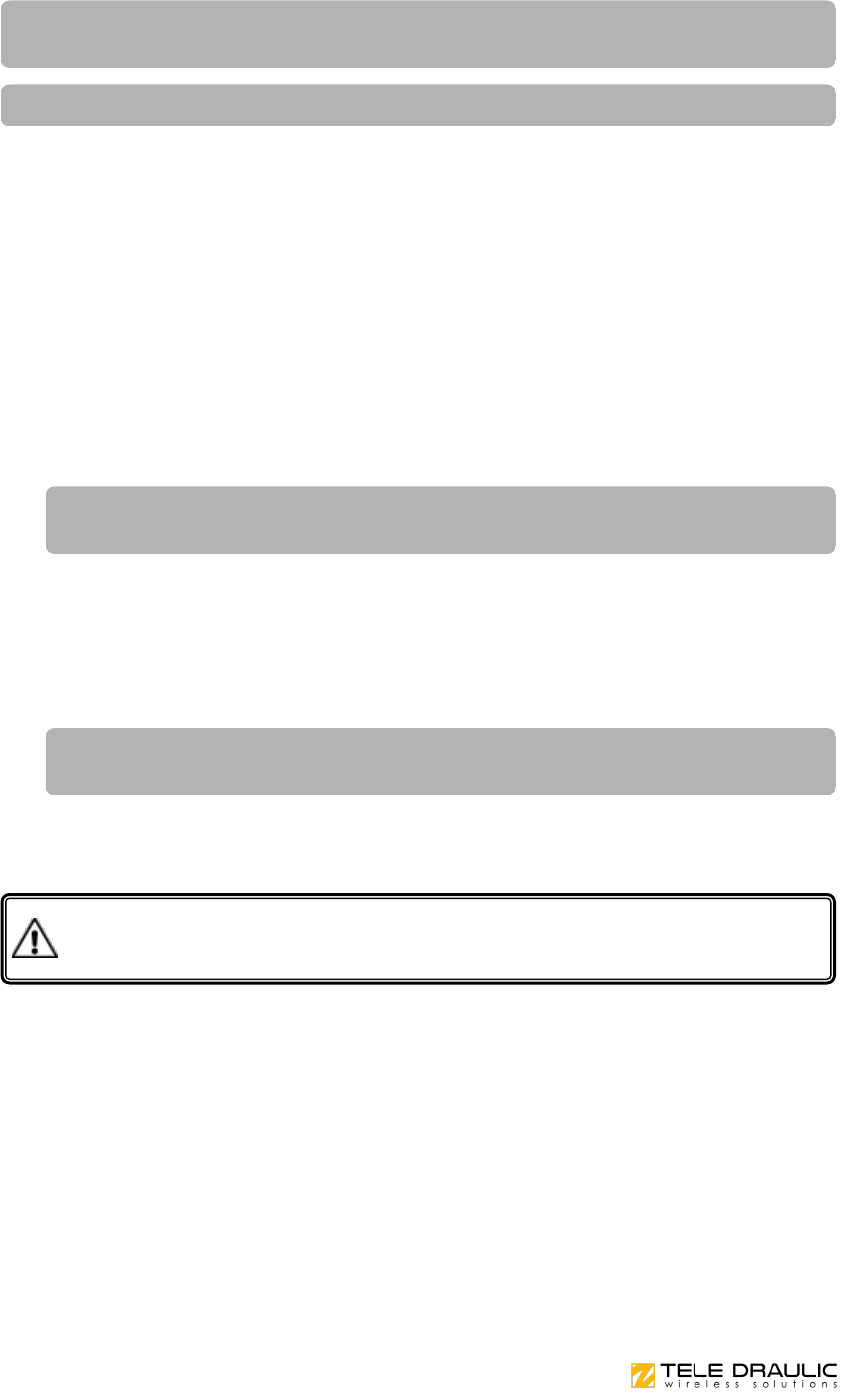
Note: Always hold the transmitter with the control panel towards you. The user must be able to
read any text on the control panel and understand the symbols on it.
Note: Transmitters not in use it must be switched off and stored in a secured storage space.
5.1 Start-up procedure
Before operating the Hydra system the following procedure must be followed.
1. Make sure that all safety measures have been followed.
2. Make sure the transmitter battery is charged.
3. Make sure that the emergency stop button is pushed in.
4. Turn the key switch to ON position (horizontal).
5. Twist and release the emergency stop button.
Initial start-up logo displays.
Battery LED indicators lights.
Note: The display shows "Session selection". Should the display show a warning on zero
position for control switch or joystick, release affected controls if necessary to proceed.
6. Press the two start buttons simultaneously. Keep pressed for a second.
7. Release both buttons.
The transmitter logs in to the receiver in which it is registered.
The middle LED flashes quickly while waiting for the receiver confirmation.
When successful the middle LED lights with a firm light.
Note: If the paired receiver is not detected within 30s, login process will be cancelled and
the transmitter will automatically turn OFF.
8. Make sure that the machine functions correspond to the transmitter functions.
9. Test emergency stop.
Do not use the system if the emergency stop button does not stop the equip-
ment. Doing so may cause serious injury or death.
17
5.2 Maintenance
lUse the stop button to start and switch off the transmitter as often as possible.
lIf error messages are shown, it is very important to find out what caused them.
lIf the stop button is mechanically damaged, contact your representative for service imme-
diately.
lAlways contact your representative for service and maintenance work on the product.
lAvoid registering transmitters in receivers where they are not being used.
lKeep the safety instructions for future reference. Always download the configuration instruc-
tions from our website for the latest available version.
lMaintenance work must be performed by qualified personnel and according to laws and reg-
ulations in the country were the system is being used.
CHAPTER 5│Installation instruction
18

Chapter 6: REGULATORY
6.1 CE marking
This product is in compliance with the essential requirements of directive 1995/5/EC of the
European Parliament and of the Council. Latest version of the EC Declaration of Conformity can
be downloaded from the Tele Radio AB website.
6.2 FCC statement
This device complies with part 15 of the FCC Rules. Operation is subject to the following two con-
ditions: (1) This device may not cause harmful interference, and (2) this device must accept any
interference received, including interference that may cause undesired operation.
Changes or modifications not expressly approved by the party responsible for compliance could
void the user’s authority to operate the equipment.
This equipment has been tested and found to comply with the limits for a Class B digital device,
pursuant to part 15 of the FCC Rules. These limits are designed to provide reasonable protection
against harmful interference in a residential installation. This equipment generates uses and can
radiate radio frequency energy and, if not installed and used in accordance with the instructions,
may cause harmful interference to radio communications. However there is no guarantee that inter-
ference will not occur in a particular installation. If this equipment does cause harmful interference
to radio or television reception, which can be determined by turning the equipment off and on, the
user is encouraged to try to correct the interference by one or more of the following measures:
– Reorient or relocate the receiving antenna.
– Increase the separation between the equipment and receiver.
– Connect the equipment into an outlet on a circuit different from that to which the receiver is con-
nected.
– Consult the dealer or an experienced radio/TV technician for help.
The radio module in this product is labelled with its own FCC ID and IC number. The FCC ID and
IC is not visible when the radio module is installed inside another device. Therefore, the outside of
the device into which the module is installed must also display a label referring to the radio mod-
ule. The final end device must be labelled in a visible area with the following:
“Contains FCC ID: ONFC1602A”
“Contains IC: 4807A-C1602A”
19
6.3 IC statement
This product complies with Industry Canada's licence-exempt RSSs. Operation is subject to the
following two conditions:
(1) This device may not cause interference; and
(2) This device must accept any interference, including interference that may cause undesired
operation of device.
Le présent appareil est conforme aux CNR d’Industrie Canada applicables aux appareils radio
exempts de licence. L’exploitation est autorisée aux deux conditions suivantes :
1) l’appareil ne doit pas produire de brouillage;
2) l’appareil doit accepter tout brouillage radioélectrique subi, même si le brouillage est susceptible
d’en compromettre le fonctionnement.
The radio module in this product is labelled with its own FCC ID and IC number. The FCC ID and
IC is not visible when the radio module is installed inside another device. Therefore, the outside of
the device into which the module is installed must also display a label referring to the radio mod-
ule. The final end device must be labelled in a visible area with the following:
“Contains FCC ID: ONFC1602A”
“Contains IC: 4807A-C1602A”
CHAPTER 6│Installation instruction
20

6.4 FCC/IC label placement
The FCC/ IC label is placed on the radio module. The radio module is fitted inside the transmitter.
6.5 Product label on the transmitter
You will find the product label on the outside of the enclosure of the transmitter.
6.6 The radio module
Each radio module is specifically designed to match a Tele Draulic product in terms of physical
dimensions, connection points, voltage levels, signal interface etc. To use the radio modules in
non Tele Draulic products is not permitted. The radio modules are designed to interface directly to
the main board of the receiver/transmitter unit. They are power supplied by the main board and the
radio circuit operates strictly according to instructions from a microprocessor on the main board.
The radio circuit configuration is stored in a flash memory on the radio module. A receiv-
er/transmitter unit with a defective/no radio module will give an error message immediately after
power up, and it will not be possible to start a radio session.
21